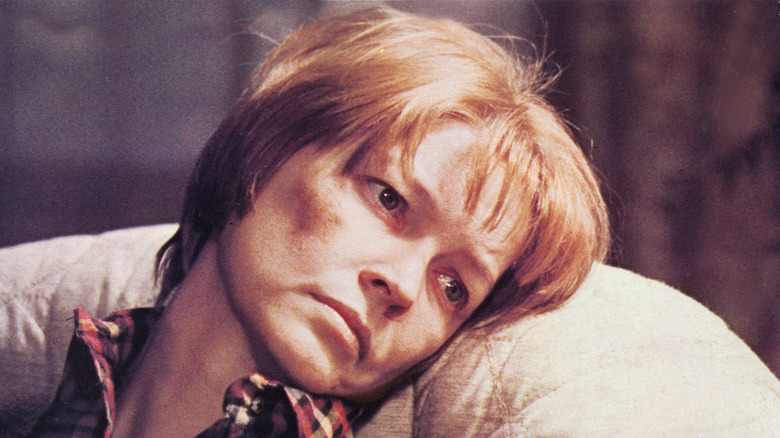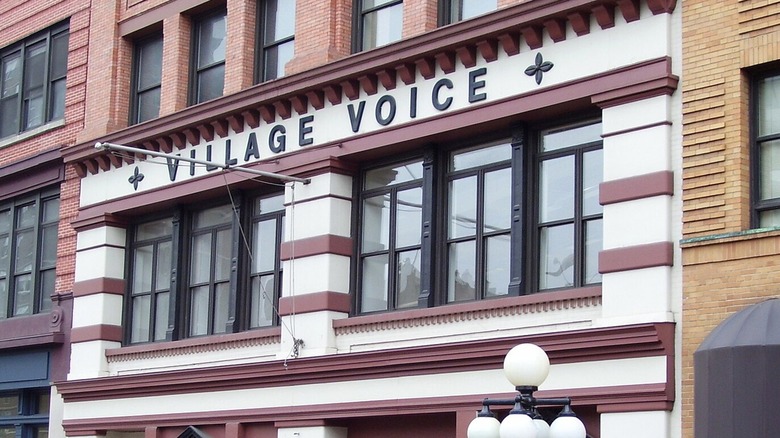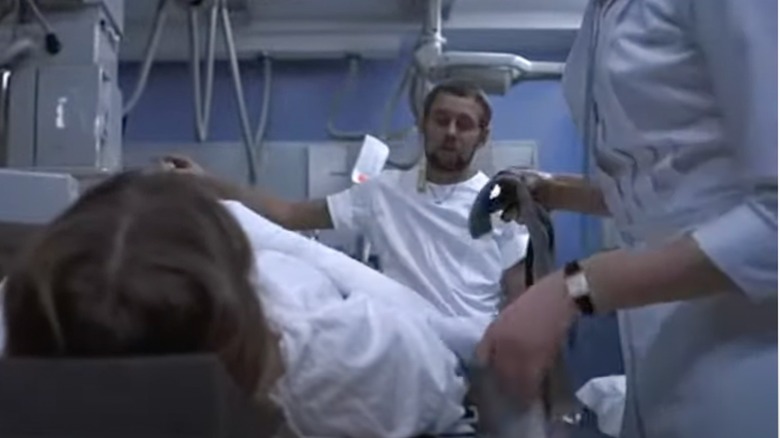The Real-Life Murderer Who Appears In The Exorcist
Despite the spider-walk and crucifix masturbation, the scene that tends to really upset viewers of "The Exorcist" is when the central character, Regan, goes in for medical testing. On the film's 40th anniversary in 2013, CNN described the queasiness with which people struggled through the realism of the scene. Producers made the unconventional decision to go to a real facility — the New York University Medical Center — and use some of their medical staff instead of actors. The scene, in which blood spurts from the 12-year-old's neck as part of the procedure, hit a nerve, even in a movie that pushed the limits of what people had seen on-screen to that point. On YouTube, commentators still write about this scene's realism, and how it's worse than any possession scene the film throws their way.
During this sequence, the bearded X-Ray tech says to the girl, "Regan, can you sit up and scoot over here ... a little more. Good," then he says "Regan, I'm just gonna move you down on the table, okay? Just for a short time." Next, the tech's hands are seen holding Regan's head still as the radiologist sticks a needle into her neck. That man was Paul Bateson, who during the filming of that movie circa 1973 was an X-ray technician at NYU's Medical Center. Though his role in the film was rather forgettable, Paul Bateson went on to be remembered for the murder of at least one person.
Murder and confession
Four years later on September 22, 1977, Arthur Bell, a writer at The Village Voice and a gay rights activist, received an anonymous phone call. About a week prior, another Village Voice writer named Addison Verrill had been found murdered in his apartment, and Bell had reported on this, with the assumption that this was another killing by a psychopathic serial killer who had been stalking the gay community. As Bell later retold in The Village Voice, the caller, who turned out to be Paul Batesoon, asked "Is that your picture on page 23 of The Voice?"
"No," Bell answered. "That's Addison Verrill."
"It sure doesn't look like Addison Verrill. I killed Addison."
"Oh. Then what did Addison look like?"
"Better than that. Look, I like your story and I like your writing, but I'm not a psychopath."
According to Bateson, who identified himself in a later interview with Bell as "not exclusively gay," he met Addison Verrill in the Badlands, a gay bar in the West Village. The men spent all night drinking and using various drugs before going back to Verrill's apartment for sex in the early morning hours. Afterward, Bateson said he felt rejected — he wanted more than sex. He told Bell, "I wanted a lasting thing, something that would go beyond sex into friendship, a lover, or marriage." However, he said, "Addison hadn't been reciprocal," so he "decided to do something I'd never done before."
Bateson said he hit Verrill over the head with a frying pan, then stabbed him in the chest with a kitchen knife. After the call, Bell went to the police.
[Featured image by Beyond My Ken via Wikimedia Commons | Cropped and scaled | CC BY-SA 4.0]
Bateson allegedly claimed to have killed others
After police honed in on Paul Bateson as their suspect, he immediately denied the allegations. According to Esquire, he claimed that he was drunk during the police interrogation, that he hadn't called Bell, and that his "confession" was simply him regurgitating the story he read in The Village Voice. No one bought it.
In 1979, The New York Times reported that Bateson was sentenced to prison for 20 years to life. It also stated the possibility that Bateson was the serial killer behind the deaths of six dismembered men who were assumed to be gay due to traces of clothes that were only sold by shops that catered to the gay community in Greenwich Village. The prosecutor, William Hoyt, claimed that Bateson had bragged to an "acquaintance" about his dismembering bodies and putting them into garbage bags. However, no evidence was ever found to connect him to these killings. That said, his imprisonment did coincide with the end of the murders.
Prison records records show that Bateson was released on parole on August 25, 2003, after having served a sentence of 24 years. After that, he disappeared. The only possible trace of him left is that JewishGen.org, a global Jewish genealogy website, has a Paul F. Benson with the same birth date and birth state, Pennsylvania, as having died on September 15, 2012, at 72 years old — 35 years and one day after he killed Addison Verrill.


